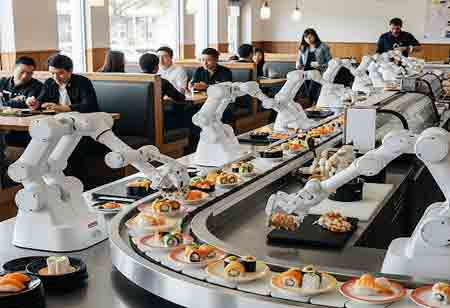Thank you for Subscribing to Food Business Review Weekly Brief
- Home
- Topics
- Alternative Proteins and Plant Based Food
- Beer and Wine
- Canned Beverages
- Coffee And Tea
- Food and Beverage Consulting
- Food and Beverage Financial Service
- Food And Beverages Marketing
- Food Distributors
- Food Ingredients
- Food Sustainability
- Plant Based Food and Beverages
- Seafood Suppliers
- Supplement Manufacturing
- Wine Investment
- News
- Vendor Viewpoint
- CXO Insights
- Conferences
- Newsletter
- CXO Awards
-
The Growing Influence of Sushi Robots in APAC

By
Food Business Review | Tuesday, May 20, 2025
Stay ahead of the industry with exclusive feature stories on the top companies, expert insights and the latest news delivered straight to your inbox. Subscribe today.

The Asia-Pacific (APAC) region is rapidly evolving as a landscape for automation in the food service industry, and the burgeoning sector of sushi robots exemplifies this trend. Driven by factors such as increasing labor costs, a demand for consistent quality, and the need for enhanced hygiene standards, the adoption of automated sushi preparation solutions is gaining significant traction across the diverse markets within APAC.
Advancements in Sushi Robot Technology
The core function of sushi robots is to automate various stages of sushi preparation, from rice cooking and handling to the precise formation of nigiri, maki, and other sushi varieties. Early versions of these machines focused on basic tasks like rice sheeting and rolling. However, modern sushi robots have advanced sensors, artificial intelligence (AI), and robotic arms that can execute intricate steps with remarkable precision and speed. This feat is sure to impress industry professionals and technology investors.
Precision in Rice Handling
One of the key areas of advancement lies in rice handling technology. Achieving the perfect texture and temperature of sushi rice is crucial for the final product's quality. Modern robots are equipped with precise temperature control mechanisms and gentle mixing paddles that mimic the techniques of experienced sushi chefs. Some systems even incorporate AI algorithms that learn and adapt to different types of rice and desired textures, ensuring consistency across large production volumes. This level of control enhances the quality and minimizes waste by accurately measuring and dispensing the required amount of rice for each piece of sushi.
Beyond rice preparation, significant progress has been made in the automation of nigiri and maki formation. Nigiri-forming robots now utilize sophisticated molding techniques to create uniformly sized and shaped rice bases, onto which toppings can be manually or automatically placed. For maki, advanced rolling mechanisms ensure tight and even rolls, which are then precisely cut into uniform pieces. Some high-end robots feature multi-axis robotic arms with the dexterity to handle delicate ingredients and execute complex rolling patterns, catering to a broader variety of maki styles. Furthermore, hygiene remains paramount in food preparation, and automated systems offer inherent advantages. Sushi robots are typically constructed from food-grade stainless steel and easily sanitizable materials. The enclosed nature of the operation minimizes human contact with the food, reducing the risk of contamination. Automated dispensing and portioning also contribute to better hygiene by controlling the handling of ingredients.
Expansion Beyond Traditional Restaurants
The application of sushi robot technology spans a broad spectrum within the APAC food service industry. High-volume sushi restaurants and chains increasingly adopt these systems to streamline operations, reduce labor costs, and maintain consistent quality across multiple outlets. While this can lead to job displacement, it also creates opportunities for employees to focus on other aspects of the business, such as customer service and menu development. Robots' ability to work continuously and at a high pace makes them particularly valuable during peak hours, improving efficiency and customer satisfaction.
Beyond traditional restaurants, sushi robots enter other food service environments. Supermarkets and grocery stores with in-house sushi counters use these machines to prepare fresh sushi for grab-and-go options. The automated process allows for efficient production and packaging, meeting the demands of busy shoppers. Similarly, catering companies and institutional food service providers, such as those serving hospitals and corporate cafeterias, are leveraging sushi robots to handle large-scale sushi preparation with consistent quality and hygiene.
Integrating robotics into sushi preparation also opens up possibilities for innovative service models. We are seeing the emergence of automated sushi kiosks and even mobile sushi preparation units equipped with robots. These setups can operate with minimal human intervention, offering convenience and accessibility in various locations.
The APAC market for sushi robots is characterized by various suppliers, from established industrial automation companies to specialized manufacturers focusing solely on food preparation robotics. These players are continuously innovating, introducing new features and functionalities to cater to the industry's evolving needs. The competitive landscape fosters technological advancements and drives down costs, making automation more accessible to a broader range of businesses.
The sushi robot industry in APAC is poised for continued growth. Ongoing advancements in AI and machine vision are expected to enhance the capabilities of these machines further, enabling them to handle a wider variety of ingredients and perform more complex tasks, such as precise topping placement and automated quality control. The increasing acceptance of automation in the food service sector, coupled with the specific benefits that sushi robots offer in terms of efficiency, consistency, and hygiene, suggests a strong trajectory for adoption across the region. As technology evolves and becomes more cost-effective, sushi robots will likely become an increasingly integral part of the APAC culinary landscape, supporting traditional sushi establishments and new, innovative food service models. The focus will likely shift towards more compact, versatile, and user-friendly robots that can adapt to different businesses' specific needs and space constraints, presenting a promising future for technology investors.






